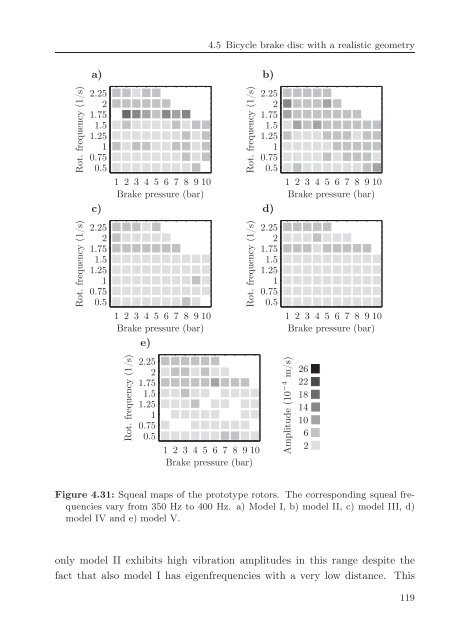- Page 1:
MECHANIK FORSCHUNGSBERICHT Avoidanc
- Page 4 and 5:
Wagner, Andreas Avoidance of brake
- Page 6 and 7:
Meinem ehemaligen Kollegen Gottfrie
- Page 9 and 10:
Kurzfassung Bremsenquietschen stell
- Page 11 and 12:
Contents 1 Introduction 1 1.1 Excit
- Page 13 and 14:
1 Introduction The technical progre
- Page 15 and 16:
1.1 Excitation mechanism of brake s
- Page 17 and 18:
1.2 Modeling and analysis of squeal
- Page 19 and 20:
1.3 Brake squeal countermeasures be
- Page 21:
1.4 Outline of the thesis concept a
- Page 24 and 25:
2 Avoidance of brake squeal by brea
- Page 26 and 27:
2 Avoidance of brake squeal by brea
- Page 28 and 29:
2 Avoidance of brake squeal by brea
- Page 30 and 31:
2 Avoidance of brake squeal by brea
- Page 32 and 33:
2 Avoidance of brake squeal by brea
- Page 34 and 35:
2 Avoidance of brake squeal by brea
- Page 36 and 37:
2 Avoidance of brake squeal by brea
- Page 38 and 39:
2 Avoidance of brake squeal by brea
- Page 40 and 41:
2 Avoidance of brake squeal by brea
- Page 42 and 43:
2 Avoidance of brake squeal by brea
- Page 44 and 45:
2 Avoidance of brake squeal by brea
- Page 46 and 47:
2 Avoidance of brake squeal by brea
- Page 48 and 49:
2 Avoidance of brake squeal by brea
- Page 51 and 52:
3 Efficient modeling of brake discs
- Page 53 and 54:
3.1 A suitable modeling approach fo
- Page 55 and 56:
3.1 A suitable modeling approach fo
- Page 57 and 58:
3.1 A suitable modeling approach fo
- Page 59 and 60:
3.2 Longitudinal vibrations of an i
- Page 61 and 62:
3.2 Longitudinal vibrations of an i
- Page 63 and 64:
3.3 Free vibrations of a rectangula
- Page 65 and 66:
3.3 Free vibrations of a rectangula
- Page 67 and 68:
3.3 Free vibrations of a rectangula
- Page 69 and 70:
3.3 Free vibrations of a rectangula
- Page 71 and 72:
3.4 Application to brake discs beha
- Page 73:
3.4 Application to brake discs a) b
- Page 76 and 77:
4 Structural optimization of automo
- Page 78 and 79:
4 Structural optimization of automo
- Page 80 and 81: 4 Structural optimization of automo
- Page 82 and 83: 4 Structural optimization of automo
- Page 84 and 85: 4 Structural optimization of automo
- Page 86 and 87: 4 Structural optimization of automo
- Page 88 and 89: 4 Structural optimization of automo
- Page 90 and 91: 4 Structural optimization of automo
- Page 92 and 93: 4 Structural optimization of automo
- Page 94 and 95: 4 Structural optimization of automo
- Page 96 and 97: 4 Structural optimization of automo
- Page 98 and 99: 4 Structural optimization of automo
- Page 100 and 101: 4 Structural optimization of automo
- Page 102 and 103: 4 Structural optimization of automo
- Page 104 and 105: 4 Structural optimization of automo
- Page 106 and 107: 4 Structural optimization of automo
- Page 108 and 109: 4 Structural optimization of automo
- Page 110 and 111: 4 Structural optimization of automo
- Page 112 and 113: 4 Structural optimization of automo
- Page 114 and 115: 4 Structural optimization of automo
- Page 116 and 117: 4 Structural optimization of automo
- Page 118 and 119: 4 Structural optimization of automo
- Page 120 and 121: 4 Structural optimization of automo
- Page 122 and 123: 4 Structural optimization of automo
- Page 124 and 125: 4 Structural optimization of automo
- Page 126 and 127: 4 Structural optimization of automo
- Page 128 and 129: 4 Structural optimization of automo
- Page 132 and 133: 4 Structural optimization of automo
- Page 134 and 135: 4 Structural optimization of automo
- Page 136 and 137: 4 Structural optimization of automo
- Page 138 and 139: 5 Conclusions After a short introdu
- Page 140 and 141: 128
- Page 142 and 143: Bibliography [10] Barthold, F.J.; S
- Page 144 and 145: Bibliography [33] Grandhi, R.: Stru
- Page 146 and 147: Bibliography and negative penalty p
- Page 148 and 149: Bibliography [74] Massi, F.; Gianni
- Page 150 and 151: Bibliography [96] Schumacher, A.: O
- Page 152 and 153: Bibliography [117] Takahashi, S.: V
- Page 155 and 156: Bisher sind in dieser Reihe erschie
- Page 157 and 158: Band 20 Finite-Element-Modelle zur
- Page 159: Brake squeal is a high-pitched nois

















